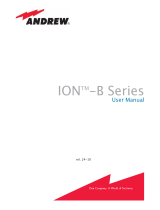Page is loading ...

Page 1 399G182 Rev D 21 January 2021
Transceiver/antenna splitter
The FSII-SPL transceiver/antenna splitter is a device that connects multiple transceiver/antennas to an
Eclipse matrix (E-Que-HX card) or FreeSpeak II Base Station. It has a matrix RJ-45 connector that carries
the data between an E-Que card transceiver port and the splitter, and five antenna RJ-45 connectors to feed
that information to and from up to five antennas. The splitter must be locally powered using the supplied
external in-line universal power supply.
In addition, the FSII SPL provides fiber linking to a FSII-Base-II Base Station and another FSII-SPL unit.
There are eight DIP switches to select the mode of operation, and to enable Local DECT synchronization and
software updates.
You can mount the splitter on a flat surface or on a microphone stand using the screw points or stand
connectors.
The FSII-SPL is compatible with both FSBP (FreeSpeak I) and FSII-BP (FreeSpeak II, 1.9 & 2.4) systems.
FSII-SPL front connector panel
FSII-SPL Front Connector Panel
Antenna Connection LEDs
These yellow LEDs indicate that the splitter is receiving data from the antennas.
Base Connection LEDs
Connection to Base; RJ45 or fiber.
• If the LEDs are steady on, DECT synchronization is being received from the Base Station/matrix.
• If the LEDs display a double flash, DECT synchronization is occurring locally.
• If the LEDs display a rapid pulse flash, there is no DECT synchronization (fault condition).
Power LED
This green LED indicates that the splitter is receiving power.
FreeSpeak II
®
Transceiver/antenna splitter
Quick
Start
Guide

Page 2 399G182 Rev D 21 January 2021
FSII SPL rear panel
FSII-SPL Rear Connector Panel
DC IN power connector
This connector is used to locally power the splitter with the supplied universal power supply. Use of local
power is required.
Fiber connection to Base Station or another FSII-SPL unit
This connector uses a Fiber Module (Part# HCI-SMFO or HCI-MMFO)
RJ45 connection to Base Station or matrix
One EtherCON RJ-45 connector
Antenna connectors
Five EtherCON RJ-45 connectors
Connecting and using a splitter
Connect the FSII-SPL base connector to matrix E-Que (RJ45 connection) or Base Station antenna port (can
be RJ45 or fiber). Connect all antennas (up to 5) to splitter antenna ports. Also make sure that the both the
power LED (green for 1.9 GHz, blue for 2.4 GHz) and the yellow data LED are lit on each antenna. If all are
properly lit, then the connection has been successfully made and the coverage zones will be active and will
support beltpacks. If the transceiver antennas are not lit, check the connections.
Note: For 24 AWG Cable: distances under 100m (328 feet), antennas can be powered by the splitter. Above
100m they must have direct/local power.
For 26 AWG Cable: distances under 50m (164 feet), antennas can be powered by the splitter. Above 50m
they must have direct/local power.
Make any necessary DIP switch settings (mode of operation, local DECT synchronization, firmware update).
DIP switch settings (default in BOLD)
1 to 5
Antenna ports 1 to 5
ON – Active
OFF - Convert to Fiber
6
ON – Base Sync
OFF – Local Sync
7
If 6 is switched to OFF
ON – FreeSpeak II
OFF – FreeSpeak I
8
ON – Update
OFF – Normal operation
To access the DIP switches, remove
the covering panel on the base of the
splitter (two screws).
Note: When you change a DIP
switch setting, you must re-
power the unit for the change to
have any effect.

Page 3 399G182 Rev D 21 January 2021
Note: Splitter daisy-chaining is not available when using E1 with an E-IPA card.
Copyright © 2021 HME Clear-Com Ltd. All rights reserved.
/
